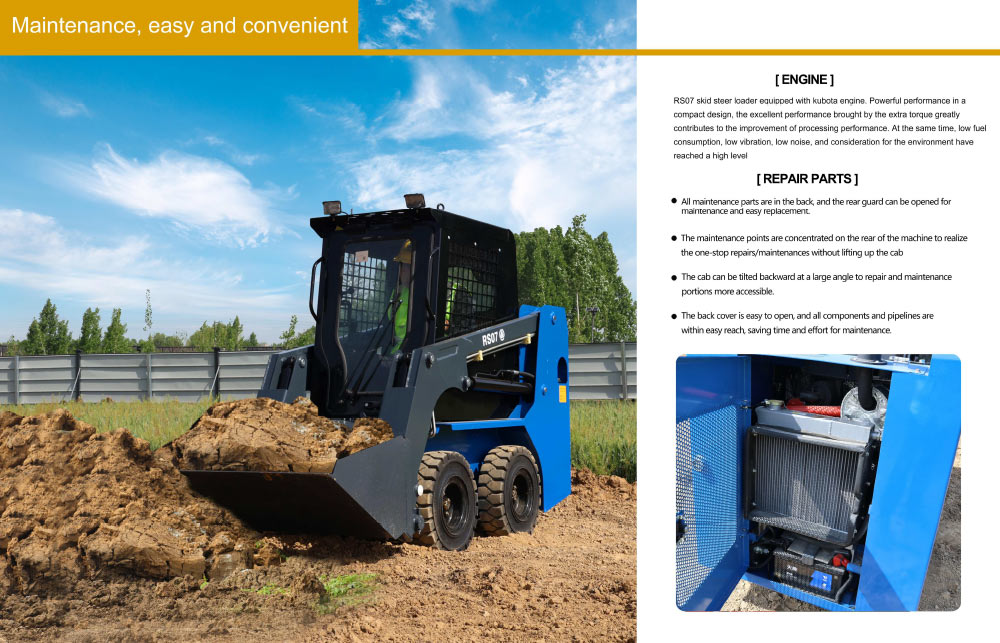How to Maintain Skid Steer Attachments for Long-Term Performance
Daily Inspections to Prevent Damage
Regular inspection is essential to prevent equipment failure and costly downtime. Before each use, operators should carefully examine skid steer attachments for cracks, broken welds, or loose bolts. Special attention should be given to mounting plates and attachment frames, as these areas endure the most stress during operation. Hydraulic hoses should be checked for leaks, cracks, or abrasion, and couplers should be firmly connected. Lubrication points must be greased according to manufacturer recommendations to reduce metal friction and prevent premature wear.
Visual inspection takes only a few minutes yet plays a major role in detecting early signs of mechanical issues. Ignoring small defects can lead to larger breakdowns, especially in attachments like trenchers, augers, and grapple buckets. Early maintenance action significantly extends attachment life and improves job site efficiency.

Cleaning Attachments After Each Use
Dirt buildup is one of the most common causes of attachment malfunction. Mud, rocks, and debris can interfere with moving parts and cause unnecessary strain on the hydraulic system. After each job, attachments should be thoroughly cleaned using water or compressed air. Areas around pivot pins, joints, and rotating components should always be kept clear.
For trencher chains, auger bits, and brush cutter blades, compacted soil or vegetation must be removed before storage. Cleaning prevents rust, corrosion, and hydraulic contamination. Clean equipment is also easier to inspect and lubricate, making maintenance safer and faster.
Hydraulic System Care for Smooth Performance
Most skid steer attachments rely on hydraulic power, making hydraulic system maintenance critical. Oil levels must be monitored regularly, and only the manufacturer-approved hydraulic fluid should be used. Contaminated or incorrect fluid reduces performance and can damage internal seals and pumps.
Hydraulic filters should be replaced according to service schedules, especially when attachments are used in dusty or heavy-duty environments. Quick couplers must be cleaned before connecting to prevent dirt from entering the machine’s hydraulic system. A single contaminated connection can cause system-wide failure.
Sharpening and Replacing Wear Parts
Working attachments such as buckets, augers, breaker hammers, and stump grinders rely on sharp cutting edges. Worn or dull teeth force the skid steer to work harder, reducing hydraulic efficiency and increasing fuel consumption. Operators should inspect cutting blades, chains, and edge plates at least once a week.
Replacement parts should be installed before excessive wear affects performance. Using high-quality components will deliver smoother work results and prevent vibration-related damage to the machine. Timely replacement ensures consistent productivity on demanding job sites.
Proper Storage for Maximum Durability
Proper storage protects skid steer attachments from harsh weather and corrosion. Attachments should always be stored indoors or covered with protective material. Hydraulic-powered tools should have their couplers capped during storage to keep moisture and dust out.
When attachments are stored for long periods, applying a light oil film or rust inhibitor on exposed metal surfaces prevents corrosion. Storage surfaces should be flat and secure to prevent tipping or frame distortion.
Troubleshooting Common Attachment Problems
Attachment does not move: Hydraulic pressure may be blocked. Check couplers for improper connection or trapped pressure.
Weak power or slow movement: Filter blockage or low hydraulic flow may be the issue. Inspect hoses and clean screens.
Uneven digging or cutting: Worn or misaligned teeth or blades require adjustment or replacement.
Excessive vibration during operation: Loose bolts or worn bushings should be tightened or replaced.
Hydraulic overheating: Dirty oil, incorrect fluid, or internal leaks may be the cause. Inspect fluid condition and system components.
By understanding these common issues, operators can resolve them quickly without long delays or costly repairs.
Structured Maintenance Schedule
A consistent maintenance routine ensures long-term performance. Daily cleaning and inspection help detect issues early. Weekly checks should include lubrication and visual wear assessment. Monthly maintenance should include bolts tightening, hydraulic filter checks, and hose inspection. Keeping a maintenance log boosts repair efficiency and equipment resale value.
Safety During Maintenance
Safety must always be the top priority. Before repairing or inspecting attachments, turn off the engine, release hydraulic pressure, and remove the attachment from the quick coupler. Wearing protective gloves, eyewear, and safety boots prevents accidents. Tools should only be handled by trained operators to avoid hydraulic injury or crush hazards.
Partnering with a Reliable Manufacturer
Choosing high-quality attachments reduces long-term maintenance. Reputable brands like RIPPA manufacture skid steer attachments using reinforced steel structures, durable paint coatings, and reliable hydraulic designs. RIPPA equipment is built for rugged job sites and simplified maintenance. Standardized hydraulic connections and globally available replacement parts make owning RIPPA attachments convenient for contractors around the world.


